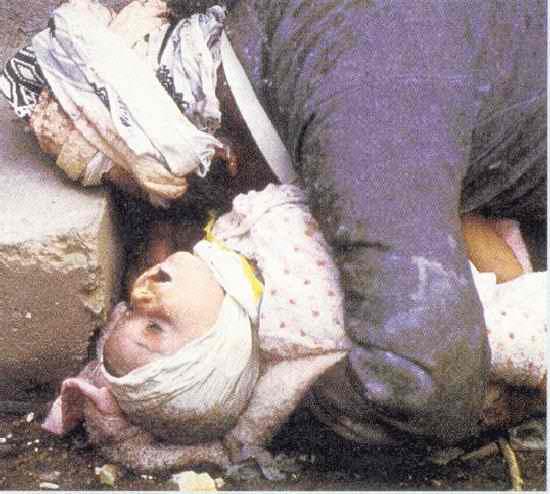
Iraq: Domestic Terror--Genocide

Figure 1.--Sadam's use of poison gas against defenseless women and children in the Kurdish village of Alaja is the most publicized of his manifold attrocities. Less well publicized are the massacres with conventional weapons in the 1,200 Kurdish villages he ordered destroyed with conventional weapons.
|
|
The most serious charges leveled against Saddam are those of genocide. Saddam's brutality has not been limited to individuals, but to whole peoples--especially the Kurds in the north and the Shi'ite Arabs in the south of Iraq. These are not small parts of the population. The Shi'ite Arabs are about 60 percent of the Iraqi population and the Sunni Kurds are about 17 percent. These two groups are in fact the great majority of the Iraqi people.
Kurds: Al-Anfal Campaign (1987-88)
The Kurds are a Sunni non-Arab ethnic group living in Iran, Iraq, Turkey, and the former Soviet Union (Armenia and Azerbijan). The Kurds have attempted to establish their own state and at times were involved in Cold War politics. They have also been used by Iran nd Iraq in the conflict between those countries. Saddam Hussein did recognize the Kurds, who populate northern Iraq and make up about 17 percent of the Iraqi population, as a constituent Iraqi ethnic group. This was more than Turkey has done. The Turks refuse to even acknowledge the Kurds, referring to them as Mountain Turks. Saddam reacted severely to Kurdish efforts to gain some autonomy. Saddam appointed Ali Hassan al-Majid secretary-general of the Ba'ath Party's Northern Region which included Iraqi Kurdistan (March 1987). Control of policies against the Kurdish insurgents was transferred from the Iraqi Army to the Ba'ath Party. The resulting campaihn became known as al-Anfal (The Spoils), a reference to the eighth sura of the Qur'an. Gradually Saddam began to attack the very fabric of Kurdish life. He ordered the destruction of thousands of villages. Many of the villagers were killed. Others were driven into cities where efforts were made to Arabize them, such as the forced adoption of Arab names. Saddam also brought in Arab settlkers from west of Mosul to repopulate the formerly Kurdish villages in an effort to change the ethnic ballance of the area. Former British Foreign Secretary Robin Cook reported, "The Amphal (phon) (Al-Anfal) campaign against the Kurds in Northern Iraq killed somewhere between 70,000 and 150,000 Kurds. Most sources report about 100,000 Kurds were killed. [Frankel, p. A1.] The order given for the campaign by one of Saddam's close relatives provides an order for free and unrestricted fire and for the execution of all males between 15 and 70 years of age. Over 1,200 villages were destroyed. It was during that campaign that Saddam employed chemical and biological weapons against the village of Alaja (phon)/Halabja where he killed some 5,000 people, overwhelmingly women and children, because the men were working in the fields (March 16, 1988). [Cook] AUnited Nations investigation reported thst musrsabd gas an an unidentified nerve sagent was used. [Hiltermann, 195.) Saddam's use of poison gas agianst the Kurds is well documented. Saddam's cousin Ali Hassan Majeed is a senior Bath Party official known as "Chemical Ali" and was responsible for the use of the gas. [Frankel, p. A12.] The images of Kurdish villagers Saddam gassed with mothers holding their children in their death agonies are hard to forget. Some who survived the attacks made it to hispitals. Many of those were arrested by security forces and killed. Some reports indicate that they were burried alive. Human Rights Watch has uncovered documents that show the brutality Saddam unleashed on the Kurds. Soldiers were ordered to execute wounded civilians, kill any civilian found in designated areas, execute after interogation all civilians between age 15-70 found in "prohibited" villages. [Frankel, p. A12.] Because of the American enforced "no-fly Zones", these attacks on the Kurds are no longer possible in Kurdistan. Medical authorities are, however, concerned about the lingering impact of the chemicals used. There continued to be deaths from those gassed, but not killed. There are abnormally high rates of still born babies and babies born with birth defects among the Kurds. In addition there is concern that the mass graves of thise killed in the gas attacks may be affecting the ground water in the areas that were attacked.
Shi'ite Arabs
Cook also reports that Saddam, "... has also practised genocide against the marsh Arabs of the south where he has drained the marshes and forced 150,000 marsh Arabs forcibly to relocate." [Cook] The suppression of the Shi'ite Arabs in various attemps to oust Saddam, most notably in 1991 has been horific.
Sources
British dossier, December 2, 2002, 23p. (Amnesty International was the source for much of the information in the British dossier.)
Cook, Robin. (British Foreign Secretary) "Standing up to Saddam's Terror State," edit transcript of press conference, December 19, 1998.
Frankel, Glenn. "A would-be Iraqi leader, caught by his past," Washington Post November 25, 2002, pp. A1 and 12.
Hiltermann, Joost R. (2007). A Poisonous Affair: America, Iraq, and the Gassing of Halabja (Cambridge University Press: 2007).
Samari, Kamal. (Amnesty International) in Glenn Frankel, "Britain releases new report alleging Iraqi rights abuses," Washington Post December 3, 2002. A21.
CIH

Navigate the Boys' Historical Clothing Web Site:
[Return to Main Iraq domestic terror page]
[Return to Main genocide/mass killing page]
[About Us]
[Introduction]
[Biographies]
[Chronology]
[Climatology]
[Clothing]
[Disease and Health]
[Economics]
[Freedom]
[Geography]
[History]
[Human Nature]
[Ideology]
[Law]
[Nationalism]
[Presidents]
[Religion]
[Royalty]
[Science]
[Social Class]
[Bibliographies]
[Contributions]
[FAQs]
[Glossaries]
[Images]
[Links]
[Registration]
[Tools]
[Children in History Home]
Created: November 21, 2002
Last updated: 6:29 PM 12/14/2018



